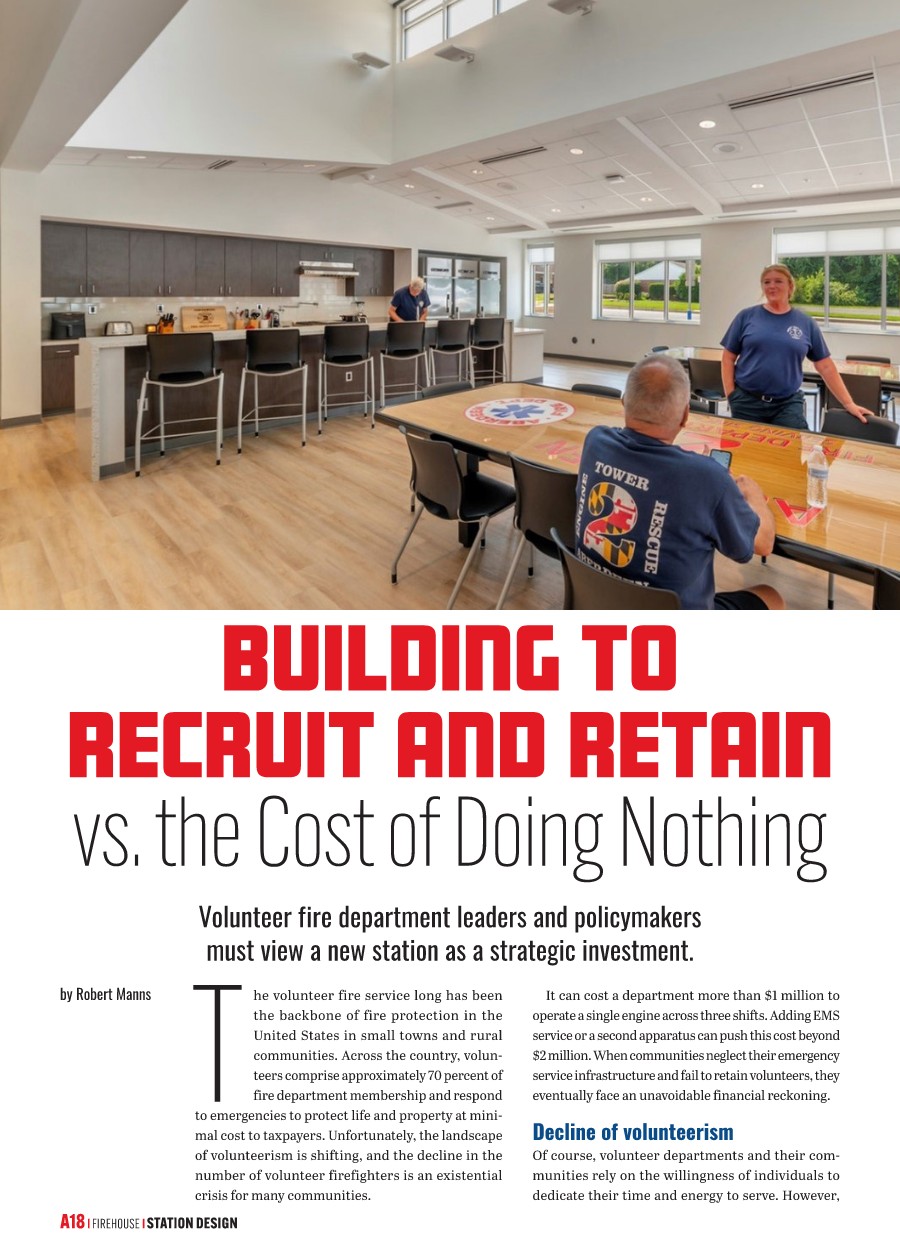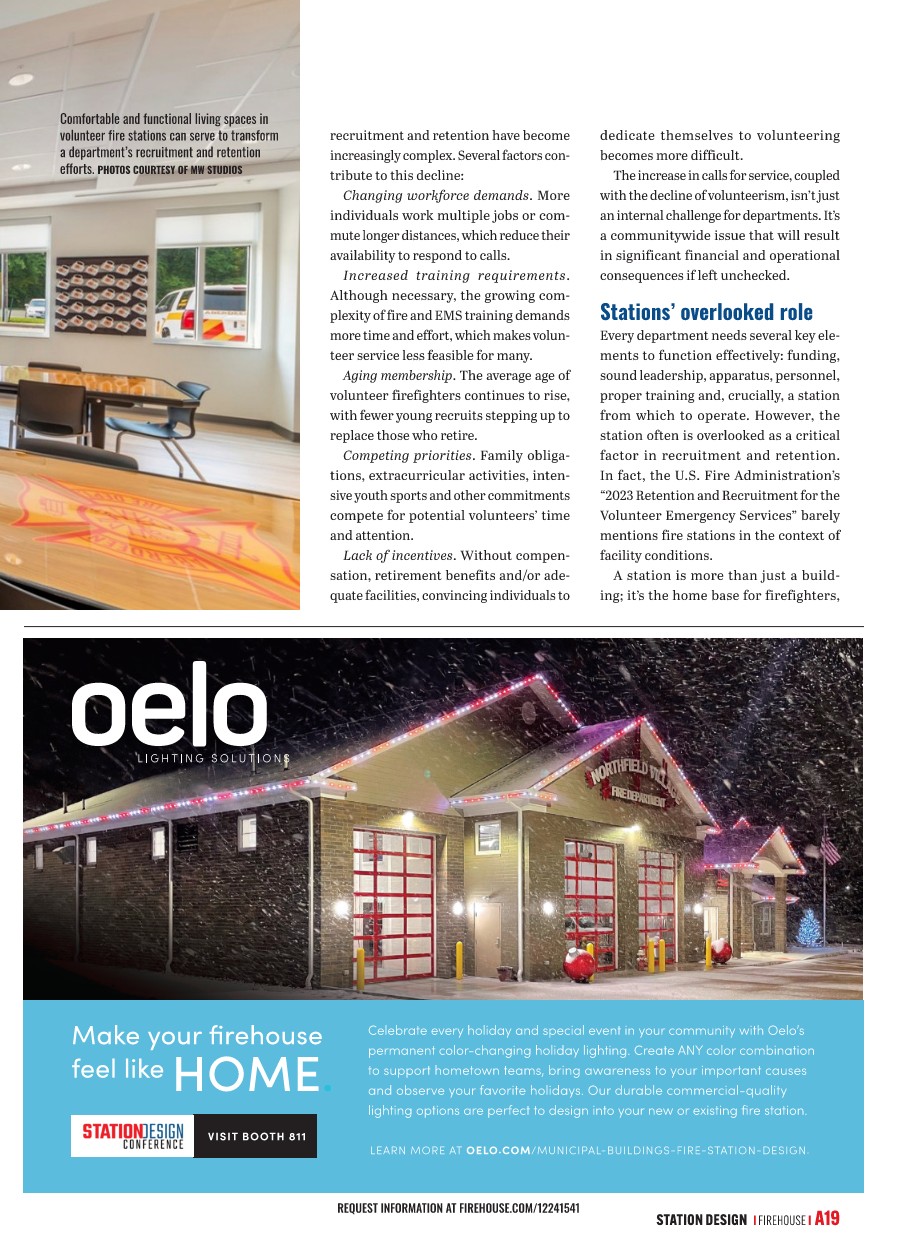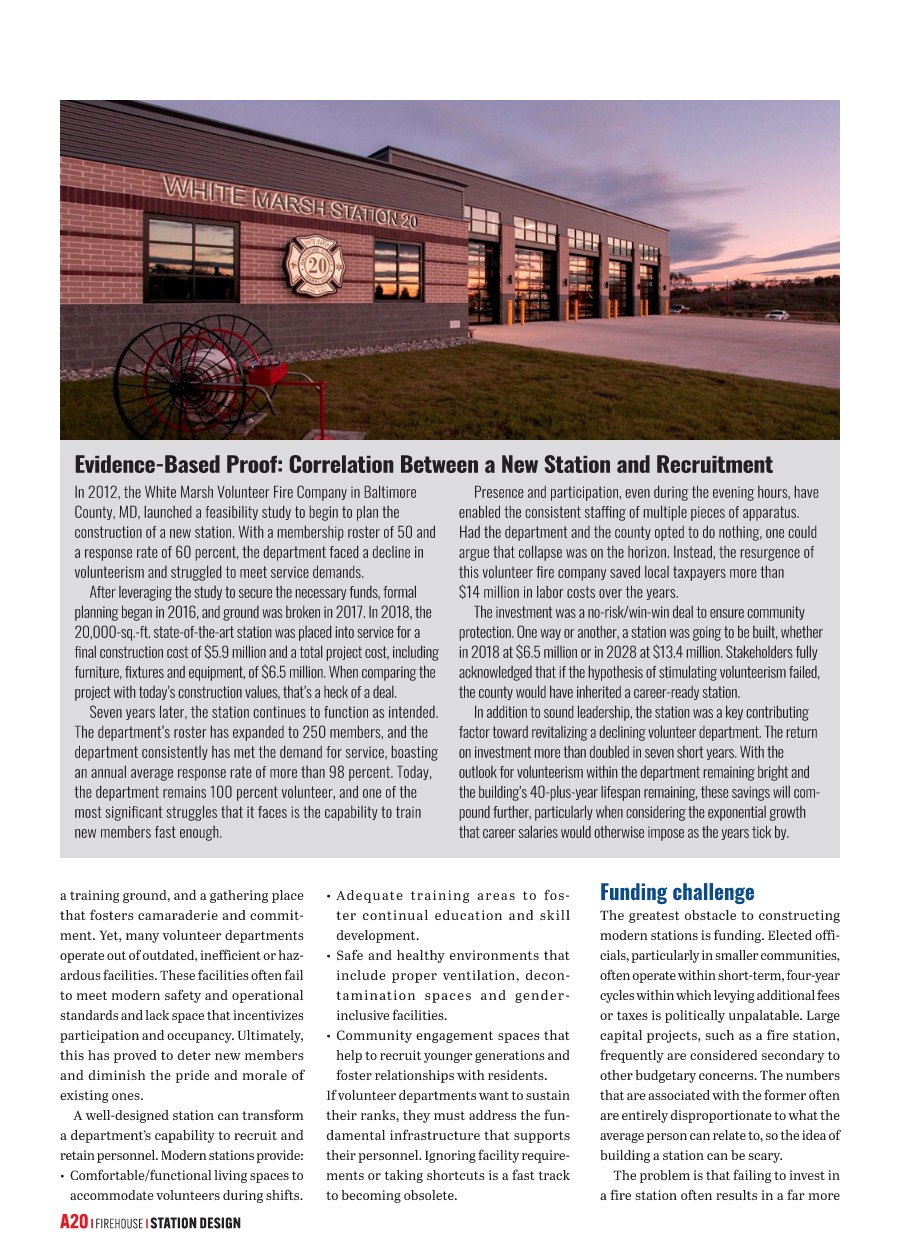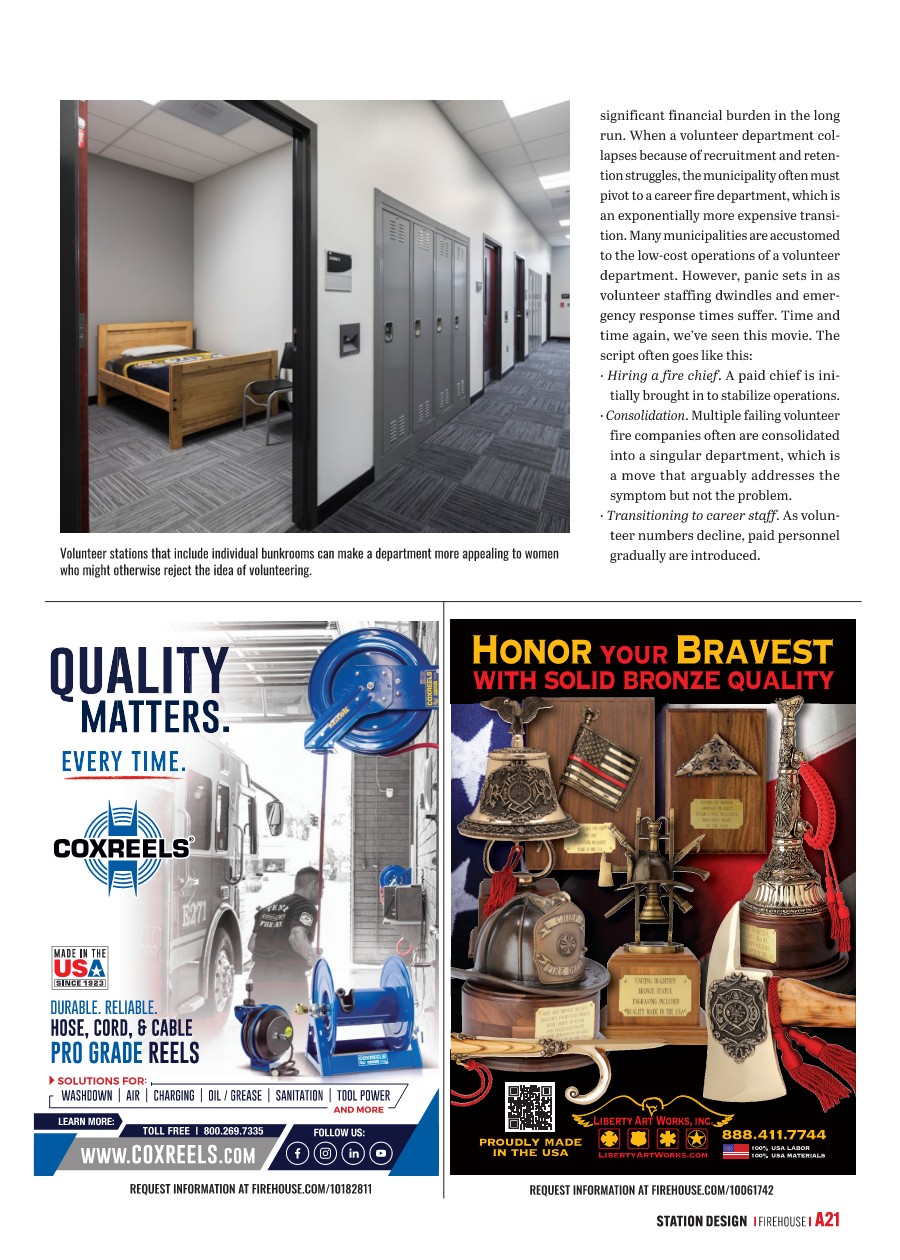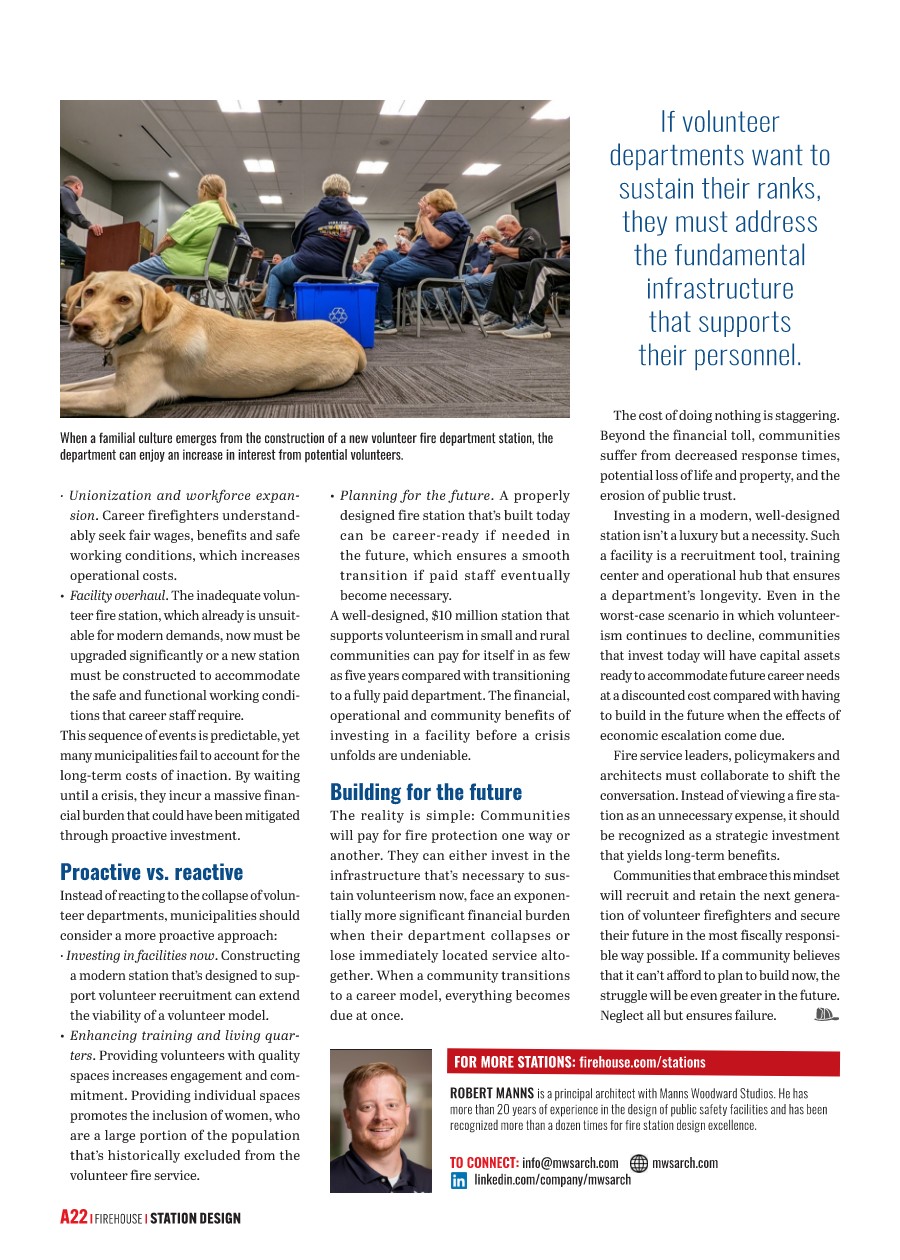In his latest article, Rob Manns explores the growing crisis in volunteer fire departments, driven by declining recruitment, aging volunteers, and outdated facilities. Functional, safe, and inclusive spaces help foster a sense of community, improve training opportunities, and attract the next generation of volunteers. Without such investment, communities risk losing their volunteer departments altogether, an outcome that forces a shift to costly career staffing.
This article is featured in the Firehouse Station Design Supplement 2025. Click the link to read the complete supplement and explore more insights from industry-leading firms.
Read Rob Mann’s full article below.
The volunteer fire service has long been the backbone of fire protection in the United States, particularly in small towns and rural communities. Across the country, volunteers staff approximately 70% of fire departments responding to emergencies, protecting life and property at minimal cost to taxpayers. However, the landscape of volunteerism is shifting, and the decline in volunteer firefighters is becoming an existential crisis for many communities.
The Decline of Volunteerism
Volunteer fire departments and their communities rely on the willingness of individuals to dedicate their time and energy to serving their communities. However, in recent decades, recruitment and retention have become increasingly complex. Several factors contribute to this decline:
- Changing Workforce Demands – More individuals are working multiple jobs or commuting longer distances, reducing their availability to respond to calls.
- Increased Training Requirements – While necessary, the growing complexity of fire and EMS training demands more time and effort, making volunteer service less feasible for many.
- Aging Membership – The average age of volunteer firefighters continues to rise, and fewer young recruits are stepping up to replace those retiring.
- Competing Priorities – Family obligations, extracurricular activities, intensive youth sports, and other commitments compete for potential volunteers’ time and attention.
- Lack of Incentives – Without compensation, retirement benefits, or adequate facilities, convincing individuals to dedicate themselves to volunteering becomes harder.
The increase in calls for service, coupled with the decline of volunteerism, is not just an internal challenge for fire departments. It is a community-wide issue that, if left unchecked, will result in significant financial and operational consequences.
The Overlooked Role of the Fire Station
Every fire department needs several key elements to function effectively: funding, sound leadership, apparatus, personnel, proper training, and, crucially, a station to operate from. However, the fire station is often overlooked as a critical factor in recruitment and retention. In fact, the U.S. Fire Administration’s 2023 Manual on Retention and Recruitment barely mentions fire stations in the context of facility conditions in its 100+ pages.
A fire station is more than just a building; it is the home base for firefighters, a training ground, and a gathering place that fosters camaraderie and commitment. Yet, many volunteer departments operate out of outdated, inefficient, or hazardous facilities. These facilities often fail to meet modern safety and operational standards and lack space that incentivizes participation and occupancy. Ultimately, this has been proven to deter new members and diminish the pride and morale of existing ones.

Investing in a well-designed station can transform a department’s ability to recruit and retain personnel. Modern stations provide:
- Comfortable and functional living spaces to accommodate volunteers during shifts.
- Adequate training areas to foster continuous education and skill development.
- Community engagement spaces that help recruit younger generations and foster relationships with residents.
If volunteer departments want to sustain their ranks, they must address the fundamental infrastructure that supports their personnel. Ignoring facility needs or taking shortcuts is a fast track to becoming obsolete.
The Funding Challenge and Political Short-Sightedness
The greatest obstacle to constructing modern fire stations is funding. Elected officials, particularly in smaller communities, often operate within short-term, four-year cycles where levying additional fees or taxes is politically unpalatable. Large capital projects like fire stations are frequently considered secondary to other budgetary concerns. The numbers associated with them are often entirely disproportionate to what the average person can relate to, so the idea of building them can be scary.
The problem is that failing to invest in fire stations often results in a far more significant financial burden in the long run. When a volunteer fire department collapses due to recruitment and retention struggles, the municipality must pivot to a career fire department, an exponentially more expensive transition.
Many municipalities are accustomed to the low-cost operations of volunteer departments. However, panic sets in as volunteer staffing dwindles and emergency response times suffer. Time and time again, we’ve seen this movie. And the script often goes like this:
- Hiring a Fire Chief – A paid chief is initially brought in to stabilize operations.
- Consolidation – Multiple failing volunteer fire companies are often consolidated into a singular department, a move that arguably addresses the symptom but not the problem.
- Transitioning to Career Staff – As volunteer numbers decline, paid personnel are gradually introduced.
- Unionization and Workforce Expansion – Career firefighters understandably seek fair wages, benefits, and safe working conditions, which increases operational costs.
- Facility Overhaul – The inadequate volunteer fire station, already unsuitable for modern demands, must now be rebuilt or significantly upgraded to accommodate the safe and functional working conditions that career staff require.
This sequence of events is predictable, yet many municipalities fail to account for the long-term costs of inaction. By waiting until a crisis, they incur an astronomical financial burden that could have been mitigated through proactive investment.
The True Cost of Doing Nothing
Today, the national average annual cost to staff a single fire engine across three shifts exceeds $1 million. Adding EMS service or a second piece of apparatus can quickly push this cost beyond $2 million annually. When communities neglect their emergency service infrastructure and fail to retain volunteers, they eventually face an unavoidable financial reckoning.
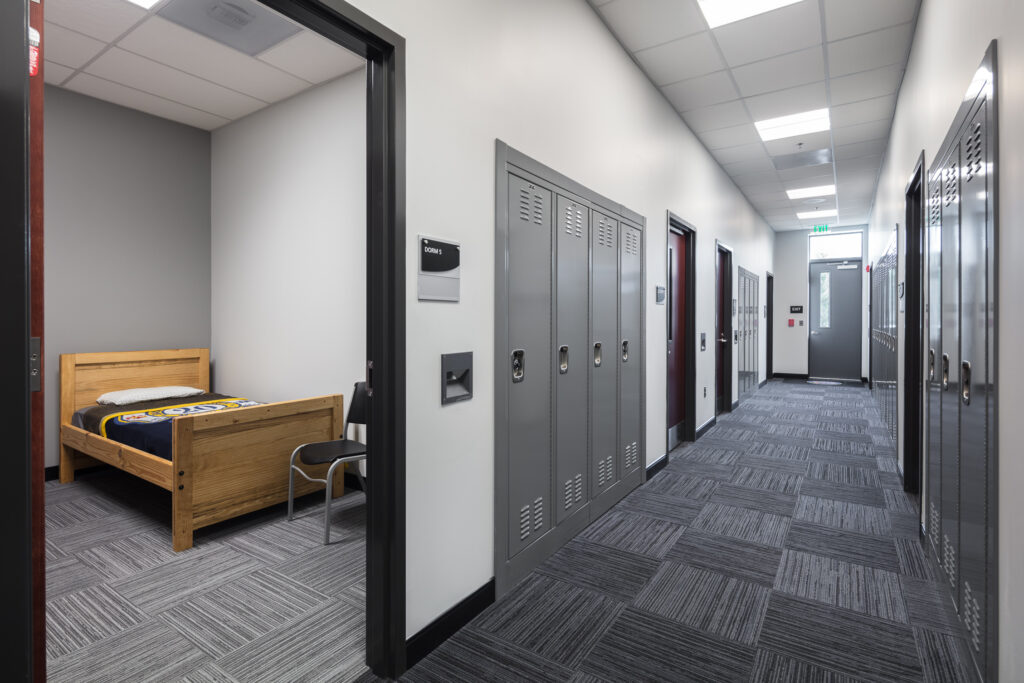
Instead of reacting to the collapse of volunteer departments, municipalities should consider a more proactive approach:
- Investing in Facilities Now – Constructing a modern fire station designed to support volunteer recruitment can extend the viability of a volunteer model.
- Enhancing Training and Living Quarters – Providing volunteers with quality spaces increases engagement and commitment. Providing individual spaces promotes the inclusion of women, a large portion of the population historically excluded from the volunteer fire service due to lack of adequate facilities.
- Planning for the Future – A properly designed fire station built today can be career-ready if needed in the future, ensuring a smooth transition if paid staff eventually become necessary.
A well-designed $10 million fire station that supports volunteerism in small and rural communities can pay for itself in as little as five years compared to transitioning to a fully paid department. The financial, operational, and community benefits of investing in facilities before a crisis unfolds are undeniable.
Building for the Future
The reality is simple: communities will pay for fire protection one way or another. They can either invest in the infrastructure necessary to sustain volunteerism now or face an exponentially more significant financial burden when their fire department collapses. When that occurs, the community must transition to a career model, and everything becomes due at once.
The “cost of doing nothing” is staggering. Beyond the financial toll, communities suffer from decreased response times, potential loss of life and property, and the erosion of public trust.
Investing in modern, well-designed fire stations is not a luxury but a necessity. These facilities are recruitment tools, training centers, and operational hubs that ensure a department’s longevity. Even in the worst-case scenario where volunteerism continues to decline, communities that invest today will have capital assets ready to accommodate future career needs at a discounted cost compared to having to build in the future, where the impacts of economic escalation come due.
Fire service leaders, architects, and policymakers must collaborate to shift the conversation. Instead of viewing fire stations as an unnecessary expense, they should be recognized as strategic investments that yield long-term benefits. Communities that embrace this mindset will recruit and retain the next generation of volunteer firefighters and secure their future in the most fiscally responsible way possible.
Because, in the end, the cost of doing nothing is too great to ignore. If a community thinks it can’t afford to plan to build now, the struggle will be even greater in the future. Neglect all but ensures failure.
Evidence-Based Proof
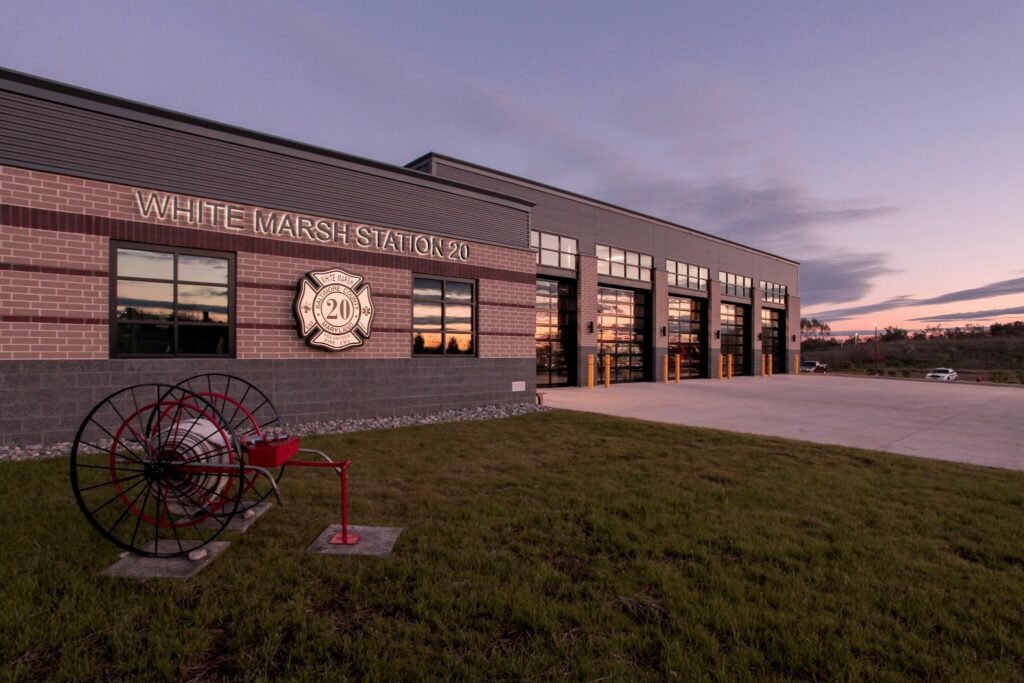
In 2012, the White Marsh Volunteer Fire Company in Baltimore County, MD, started its journey with a feasibility study to begin planning the construction of a new station. With a membership roster of 50 and a response rate of 60%, the department was facing a decline in volunteerism and struggled to meet service demands.
After leveraging the study to secure the necessary funds, formal planning began in 2016, and ground was broken in 2017. In 2018, the 20,000 square foot state-of-the-art station was placed in service for a final construction cost of $5.9 million and a total project cost, including furniture, fixtures, and equipment, of $6.5 million. When comparing the project to today’s construction values, that’s a heck of a deal.
Seven years later, the station continues to function as intended. The department’s roster has expanded to 250 members, and they have consistently met the demand for service, boasting an annual average response rate of above 98%. Today, the department remains 100% volunteer, and one of the most significant struggles they face is the ability to train new members fast enough.
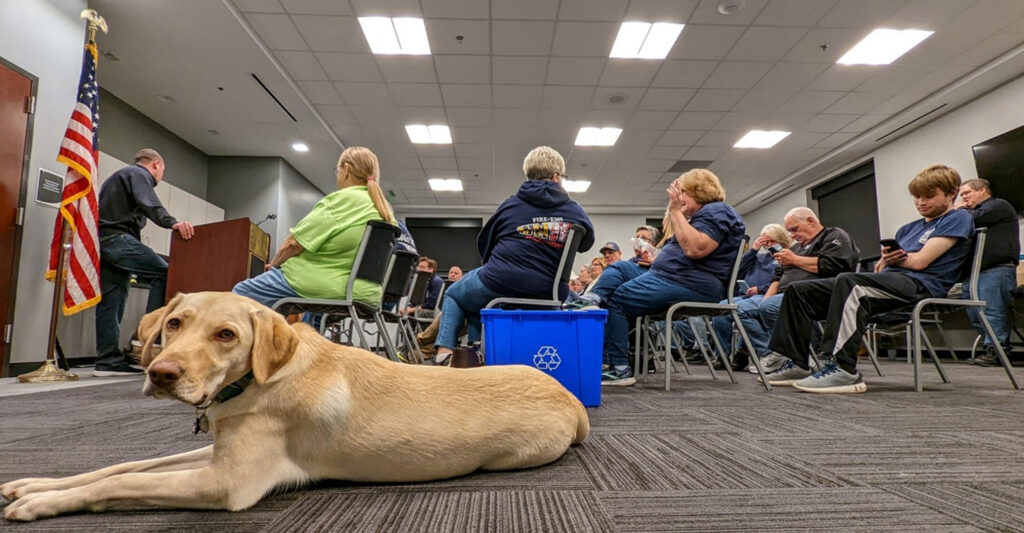
Presence and participation, even during the evening hours, have enabled the consistent staffing of multiple pieces of apparatus. Had the department and the County opted to do nothing, one could argue that collapse was on the horizon. Instead, the resurgence of this volunteer fire company has saved local taxpayers more than $14 million in labor costs over the years.
The investment was a “no-risk” / “win-win” deal to ensure community protection. One way or another, a station was going to be built. Something would need to happen, whether it was constructed in 2018 at $6.5 million or in 2028 at $13.4 million. Stakeholders fully acknowledged that if the hypothesis of stimulating volunteerism failed, the County would have inherited a career-ready station.
In addition to sound leadership, the station was a key contributing factor toward revitalizing a declining volunteer department. The return on investment has more than doubled in seven short years. With the outlook for volunteerism within the department remaining bright and the building’s 40+ years of lifespan remaining, these savings will only compound further, especially when considering the exponential growth that career salaries would otherwise impose as the years tick by.
Author

Rob Manns is a founding partner and principal architect at MW Studios, where he has dedicated the past 20 years to designing fire-rescue stations and helping departments across the country address facility challenges through strategic, forward-thinking planning. With deep expertise in both architecture and public safety operations, Rob brings a unique perspective to creating spaces that not only function effectively but also strengthen recruitment, retention, and community connection. His work continues to shape the future of fire station design nationwide.
Interested in learning more? Visit our insights page to explore additional articles and thought leadership from the MW Studios team.
